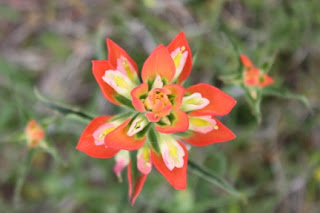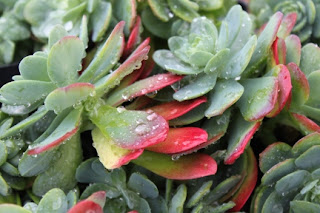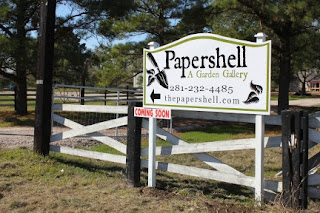Wednesday I had the great good fortune to attend a seminar at
Spring Creek Growers, presented in part by
Ball Horticultural Company. The idea is introduce garden center folks and landscape contractors to the newest, most innovative "plant material" out there, in the hopes that we can entice our own customers to buy them. (That's what they call it sometimes,
plant material. Isn't that a little, well, dreary?)
 |
| 'Phantom' Petunia |
I love these events. I love to hear about all the research and development that goes into the creation of a "new" plant. I get all plant-geeky inside, just hearing words like
vegetative or
triploid. And the facility at Spring Creek is very, very nice, and the food was delicious, and it makes for a great start for the spring season.
 |
| 'Breathless' Euphorbia |
What thrills me about springtime, though, does not necessarily thrill the customers. The panel discussion pointed up a disconnect between what the Ball folks were promoting, and what the landscape contractors, re-wholesalers and garden center owners were looking for. The Ball representative started the discussion by asking each of the participants how they felt about new plants, new innovations, new products. You could tell he was very excited about Ball's product line, and he was right to be -- there are some very interesting new plants on the market. However...
 |
| Zinnia 'Zahara Double Duo' |
One by one, the panel participants said, in not so many words, that simply being "new" was not good enough. The landscape contractor said that her clients never come to her, asking for the newest thing. They rely on her to put together a plan that works for them, in their budget. She believed it was important
for her to find out about new plants, but the customer wasn't driving that. The garden center owner said that a few of her customers came into the store looking for the latest in new plants, but that only happened if there were a big national marketing push behind the product. She also said that much of the time, the new products failed to deliver on the promises made by these marketing campaigns. The Wave petunias are a good example -- they don't perform here nearly as well as promised here, in our climate, as other petunias might. The rewholesaler, who provides plants primarily to landscapers, said that he had to push the new products -- there wasn't a demand from his clients specifically for the newest varieties.
 |
| Coleus 'Redhead' |
|
The discussions went on in this vein for about half an hour. None of the panelists were using social media or traditional advertising to promote new products. None of the panelists felt that "newness" provided a higher price point or profit margin. In fact, while there was excitement about specific plants, I thought I detected a general skepticism about "newness" in general. Simply being new doesn't mean a plant can solve a customer's problem or meet a customer's need. It's hard to say what was going through the Ball rep's mind -- he put up a good front. But it's got to be discouraging to have your customers tell you new's not where it's at.
 |
| Verbena 'Aztec' |
I'll put my customer hat on for a minute. Would I rather have a new petunia, in the rare and unusual shade of black? Or would I rather just have a petunia that can make it longer through the heat and humidity of our summers? I appreciate what Ball's doing here and I love some of the new plants. But I hope they don't overestimate the importance of new and different. I think many of us would be satisfied with a good quality, virus-free same-old, same-old.
All photos courtesy Ball Horticultural Company, and a big thanks to Spring Creek Growers for hosting us. It was a very interesting, thought-provoking event!






















































.jpg)




